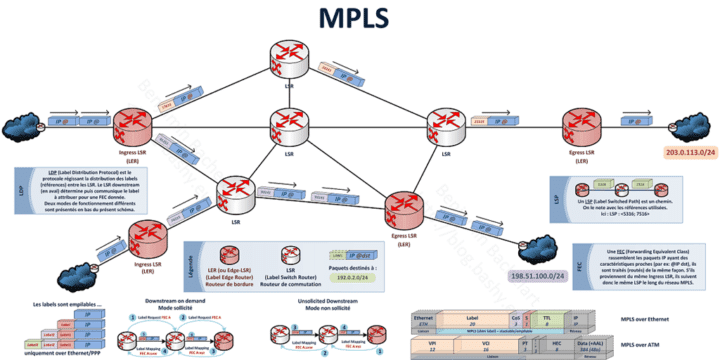What Is MPLS and Why do we need it?
Multi-Protocol Label Switching (MPLS) in simple terms, which enables a Service Provider (SP) to offer scalable and internetworking solutions for its clients. In addition to scalability, MPLS offers Traffic Engineering (TE) and Quality of Service (QoS). While TE is more oriented towards SP, scalability and QoS features will benefit both SP and its customers. What MPLS does is an addition of one or more labels which is inserted between Layer 2 header and Layer 3 header in a datagram. An additional label offers one more way of packet forwarding in addition to the traditional IP lookup. Since the MPLS label is placed just before Layer 3 header and after Layer 2 header, an SP router uses MPLS label in its core to make forwarding decisions, instead of Layer 3 information. Now, let me try to answer the question : ?Why do we need MPLS??.
Scalability: In this age of globalisation, business is expanding like never before. As businesses reach more destinations, their need of being connected with other locations increases. Expansion can introduce difficulties for organizations as well as Service Providers. When the number of locations getting connected to each other increases, it becomes very difficult to manage. Service Providers face more problems because they have to serve multiple customers and everyone is reaching out for more and more locations. To add to this problems, the competition in the market has also grown up significantly, which forces Service Providers to offer cost effective and easy to manage solutions to their customers. MPLS is an answer to all such issues. MPLS gives service providers ability to scale up very easily and without difficulty. In the early days of Internetworking, a service provider had to manage many virtual circuits, deal with different technologies and all. But with MPLS enabled cores, it has become very easy for them to manage such situations. Further, they can reach out to other expanding markets ? even those markets where they have no physical presence, also without much complications through Network-to-Network Interface (NNI). NNI is a kind of partnership with another service provider who can deliver connectivity links in the target market.
For customers, they can expand their core business without having to worry about the connectivity issues. Since SP can also participate in the connectivity for them, they do not have to deal with many issues like managing their own routing ? which many organizations used to do earlier. With the emergence of Managed Solutions, customers can free themselves of managing the network connectivity. The SP will take care of all their connectivity needs.
Quality of Service: With multimedia applications gaining popularity and migration towards IP based PABX systems, it is essential to have QoS in place. IP based voice service needs to have more priority as it is very sensitive to delay, jitter etc. Also, more and more video applications are finding its place in enterprise networks as Video Conferencing and Telepresence solutions can bring down the cost of travel and save time. Such applications also need to be given priority in addition to the business critical applications. Earlier, ATM was the answer for many people to have QoS. But the things have changed as usage of ATM itself needs migration to another technology and it requires capital expenditure also. MPLS can provide ATM like QoS features. MPLS label has a 3 bit field called Traffic Class (TC) which was formerly known as EXP (Experimental) field. Core routers can provide different set of treatment for each MPLS frame based on the value of TC.
Flexibility: As a technology, MPLS imposes few restrictions on interoperability with other technologies. Suppose, for a customer who has got global presence needs to connect his various offices across the globe. Most of the Service Providers in North America would be offering SONET/ATM based connectivity, while their European counterparts may be using SDH. Many countries in Asia are using Ethernet as a preferred technology for WAN connectivity. In such cases, it becomes a pain to make all these technologies to work together using plain IP VPN. Different technologies may need more technological as well as capital expenditure. But MPLS makes this easy. MPLS can interoperate with various technologies. With Any Traffic over MPLS (AToM) a Service Provider can transport Layer 2 frames over MPLS backbone. This makes life easier for both customers and providers. Also, with Interworking IP, one can have a Layer 2 VPN with Serial link on one side and Ethernet on the other side.
Besides the flexibility with technology itself, the Service Provider can offer both Layer 2 and Layer 3 VPNs on the same platform. Customers who want to manage their routing can do it themselves with Layer 2 VPN and others can use Layer 3 VPN. Such a common platform can would make the life easy for a sales guy who can very well address the customer requirements and offer exciting solutions.
Traffic Engineering: This is a feature that every Service Provider would love to use. Mostly, SPs would be having more than one link between different routers, both for redundancy and for meeting customer requirements. The problem arises, when the bandwidth of these links are different. SP can configure the load sharing between these links using various IGP features, but that may prove to be very difficult and the model itself is not scalable. If the configurations are not properly documented, troubleshooting can be a pain. MPLS traffic Engineering can address such scenarios. The use of TE along with IGP can provide better solution.
MPLS is more oriented towards Service Providers. A customer network need not be aware of MPLS and for most of the links a default route from Customer router to Provider router is enough. While a provider can address the network scalability and redundancy issues, customer can concentrate on his core business without having too much bothered about network connectivity.



